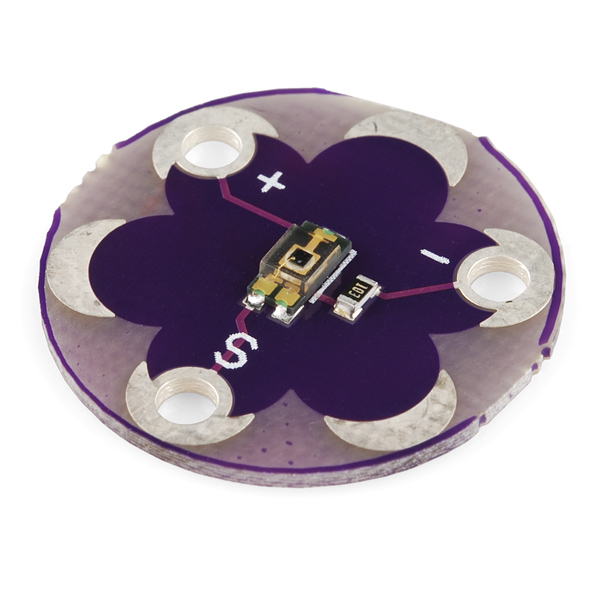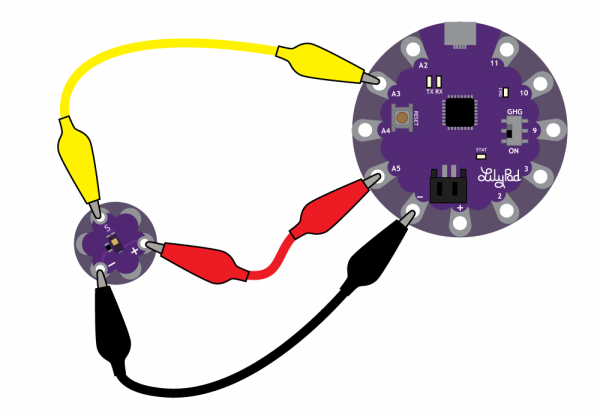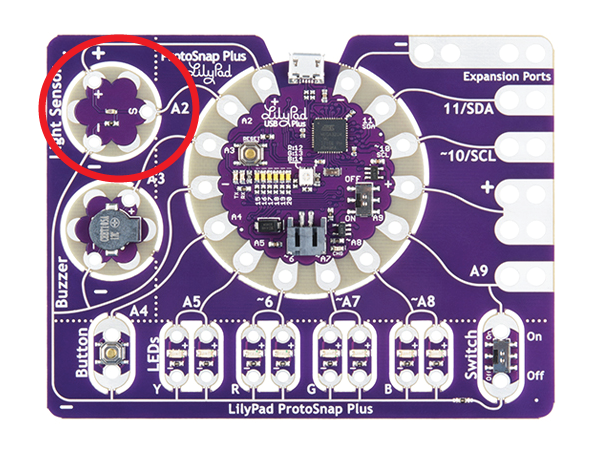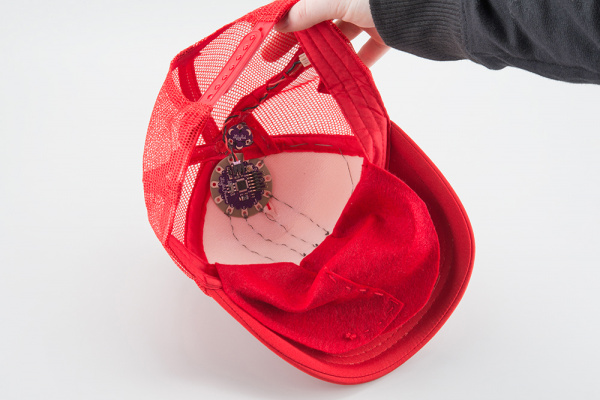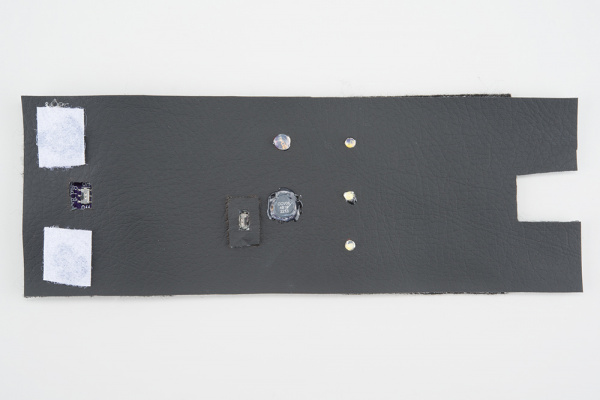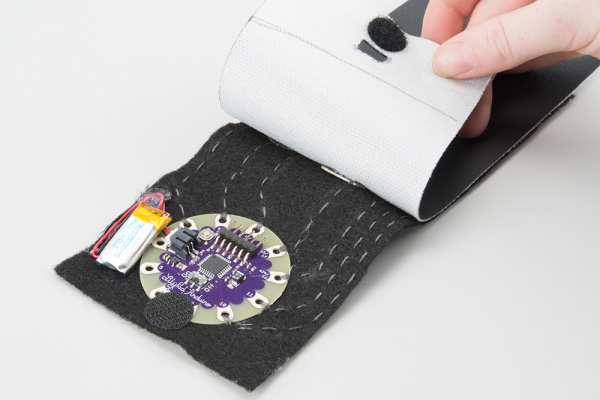LilyPad Light Sensor Hookup Guide
Introduction
The LilyPad Light Sensor is an e-textile friendly version of the Ambient Light Sensor Breakout. If you've used the breakout in a project before, the hookup and code will be very similar. You will need to connect to a LilyPad Arduino or other microcontroller to read the sensor values and use in your code.
This sensor outputs an analog value from 0 to 3.3V. In bright light (full daylight) this sensor will output 3.3V, and if completely covered will output 0V. In a typical indoor lighting situation, the sensor will output from around 1 to 2V.
LilyPad Light Sensor
DEV-08464To follow along with the code examples, we recommend:
Suggested Reading
To add this sensor to a project, you should be comfortable sewing with conductive thread and uploading code to your LilyPad Arduino. Here are some tutorials to review before working with this sensor:
What is a Circuit?
Light
Insulation Techniques for e-Textiles
LilyPad Basics: E-Sewing
Getting Started with LilyPad
If you have not used the TEMT6000 light sensor before, we recommend checking out the TEMT6000 Hookup Guide for basic information regarding that sensor.
TEMT6000 Ambient Light Sensor Hookup Guide
Attaching to a LilyPad Arduino
The LilyPad Light Sensor has three sew tabs - Power (+), Ground (-), and Signal (S). The signal tab should be connected to an analog tab (marked with an 'A') on the LilyPad Arduino.
To follow along with the code examples in this tutorial, connect the light sensor to a LilyPad Arduino as shown below. Use alligator clips to temporarily connect Signal to A3 on a LilyPad Arduino, (-) to (-) on the LilyPad, and (+) to A5. When you are finished prototyping, replace the alligator clips with conductive thread traces for permanent installation in your project.
Other LilyPad connection notes:
- If using the ProtoSnap - LilyPad Development Simple - attach to the metal tab at the top right of the board, this connects to A3. You can also set pin A5 to HIGH as an additional power tab, as the LilyPad Simple's tab is hard to access in the ProtoSnap format.
- If using the the pre-wired light sensor on the ProtoSnap - LilyPad Development Board, it is attached to pin A6.
Reading Values in Serial Monitor
Note: This example assumes you are using the latest version of the Arduino IDE on your desktop. If this is your first time using Arduino, please review our tutorial on installing the Arduino IDE.
After connecting the light sensor, let's take a look at the values it reads under different lighting conditions. For this we'll use analogRead() and Serial.print().
Don't forget to select the Serial Port that your LilyPad is connected to.
- If prototyping with a LilyPad ProtoSnap Plus, change sensorPin to A2.
- If prototyping with a LilyPad Development Board, change sensorPin to A6.
Copy the following code and upload it to your LilyPad.
language:c
/******************************************************************************
LilyPad Light Sensor Example
SparkFun Electronics
This example code reads the input from a LilyPad Light Sensor and displays in
the Serial Monitor.
Light Sensor connections:
* S pin to A3
* + pin to A5
* - to -
******************************************************************************/
// Set which pin the Signal output from the light sensor is connected to
// If using the LilyPad Development Board, change this to A6
int sensorPin = A3;
// Create a variable to hold the light reading
int lightValue;
void setup()
{
// Set sensorPin as an INPUT
pinMode(sensorPin, INPUT);
// Set pin A5 to use as a power pin for the light sensor
// If using the LilyPad Development Board, comment out these lines of code
pinMode(A5, OUTPUT);
digitalWrite(A5, HIGH);
// Initialize Serial, set the baud rate to 9600 bps.
Serial.begin(9600);
}
void loop()
{
// Get the current light level
lightValue = analogRead(sensorPin);
// Print some descriptive text and then the value from the sensor
Serial.print("Light value is:");
Serial.println(lightValue);
// Delay so that the text doesn't scroll too fast on the Serial Monitor.
// Adjust to a larger number for a slower scroll.
delay(200);
}
Once your code is uploaded, open the serial terminal in the IDE and see the output. Numbers should begin to stream by. Observe how the numbers change as the ambient light changes. Use your hand to cover the sensor or a flashlight to shine more light on it. Next we'll be using these values to control behaviors in our code.
Using Values to Trigger Behaviors
Next, we'll make some decisions in the code based on the light sensor's readings. This example code creates a simple automatic night light that turns on an LED when it’s dark.
We'll use the analogRead() function to get data from the light sensor and compare it to a variable we set for darkness level. When the readings from the light sensor fall below our threshold set for dark, it will turn on the LED.
You can hook up a LilyPad LED to pin 5 or use the built-in LED attached to pin 13.
language:c
/******************************************************************************
LilyPad Light Sensor Trigger - Automatic Night Light
SparkFun Electronics
Adapted from Digital Sandbox Experiment 11: Automatic Night Light
This example code reads the input from a LilyPad Light Sensor compares it to
a set threshold named 'dark'. If the light reading is below the threshold,
an LED will turn on.
Light Sensor connections:
* S pin to A3
* + pin to A5
* - to -
Connect an LED to pin 5 or use the built-in LED on pin 13
******************************************************************************/
// The dark variable determines when we turn the LEDs on or off.
// Set higher or lower to adjust sensitivity.
const int darkLevel = 50;
// Create a variable to hold the readings from the light sensor.
int lightValue;
// Set which pin the Signal output from the light sensor is connected to
// If using the LilyPad Development Board, change this to A6
int sensorPin = A3;
// Set which pin the LED is connected to.
// Set to 13 if you'd rather use the LilyPad Arduino's built-in LED.
int ledPin = 5;
void setup()
{
// Set sensorPin as an INPUT
pinMode(sensorPin, INPUT);
// Set LED as outputs
pinMode(ledPin, OUTPUT);
// Set pin A5 to use as a power pin for the light sensor
// If using the LilyPad Development Board, comment out these lines of code
pinMode(A5, OUTPUT);
digitalWrite(A5, HIGH);
// Initialize Serial, set the baud rate to 9600 bps.
Serial.begin(9600);
}
void loop()
{
// Read the light sensor's value and store in 'lightValue'
lightValue = analogRead(sensorPin);
// Print some descriptive text and then the value from the sensor
Serial.print("Light value is:");
Serial.println(lightValue);
// Compare "lightValue" to the "dark" variable
if (lightValue <= darkLevel) // If the reading is less then 'darkLevel'
{
digitalWrite(ledPin, HIGH); // Turn on LED
}
else // Otherwise, if "lightValue" is greater than "dark"
{
digitalWrite(ledPin, LOW); // Turn off LED
}
// Delay so that the text doesn't scroll to fast on the Serial Monitor.
// Adjust to a larger number for a slower scroll.
delay(100);
}
If your light sensor isn't triggering correctly, check the output of the Serial Monitor to see if there's a better value for the dark variable than what is set in the example code.
Project Examples
Light Sensitive Hat
Let your geek shine with this hat that blinks when the lights go down.
Musical Bracelet
Combining the sensor with a LilyPad Buzzer can create interesting interactive projects, for example this wearable light-controlled musical instrument or Opto-Theremin. Control tones on the buzzer by covering the LilyPad Light Sensor.
Twinkling Prom Dress
This prom dress project featured in this video uses an initial threshold setting and light sensor to trigger some LilyPad Pixel Boards.
LilyPad Safety Scarf
Create a scarf lights up when it gets dark with LilyPad and sewable LED ribbon.
LilyPad Safety Scarf
Resources and Going Further
Here are some resources for planning a project with the light sensor:
Or, you can check out these other great light-based tutorials.
